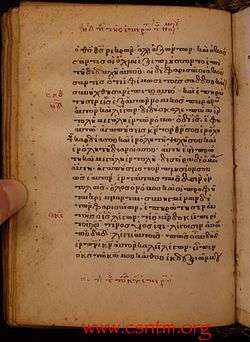Matthew 22
Matthew 22 is the twentieth-second chapter in the Gospel of Matthew in the New Testament section of the Christian Bible. Jesus continues his final ministry in Jerusalem before the Passion. Teaching in the Temple,[1] Jesus enters into debate successively with the Pharisees, the Herodians and the Sadducees, ultimately silencing them all.
| Matthew 22 | |
|---|---|
 Gospel of Matthew 22:32-44 on Minuscule 544, from 13th century. | |
| Book | Gospel of Matthew |
| Category | Gospel |
| Christian Bible part | New Testament |
| Order in the Christian part | 1 |
| Gospel of Matthew |
|---|
|
Chapters |
Text
The original text was written in Koine Greek. This chapter is divided into 46 verses.
The narrative can be divided into the following subsections:
- Parable of the Great Banquet (22:1–14)
- Render unto Caesar... (22:15–22)
- Marriage at the Resurrection (22:23–33)
- Great Commandment (22:34–40)
- "Is the Messiah the son of David?" (22:41–46)
Textual witnesses
Some early manuscripts containing the text of this chapter are:
- Codex Vaticanus (AD 325-350)
- Codex Sinaiticus (330-360)
- Codex Bezae (c. 400)
- Codex Washingtonianus (c. 400)
- Codex Ephraemi Rescriptus (c. 450)
- Codex Purpureus Rossanensis (6th century)
- Codex Sinopensis (6th century; extant verses 1-7, 13-14, 32-34)
Old Testament references
The Wedding Feast (22:1–14)
The theme of replacement is very strong here, when those who had been invited but refused the repeated invitations and even murdered the messengers, were substituted by the new people from unlikely groups, from the street corners, including both good and bad, as the guests.[4]
Verse 1
- And Jesus answered and spoke to them again by parables and said:[5]
Protestant biblical commentator Heinrich Meyer suggests that Jesus' reply, "by way of rejoinder",[6] was his answer to the chief priests' and scribes' desire to arrest him in the previous verse.[7][8] A number of modern English translations lack wording corresponding to the Greek: Καὶ ἀποκριθεὶς, kai apokritheis: for example, the Jerusalem Bible reads: Jesus began to speak to them in parables once again [9] and the New International Version reads Jesus spoke to them again in parables, saying:[10] The Revised Geneva Translation (2019) maintains the wording Then Jesus answered, and spoke to them again in parables, saying...[11]
Roman Taxation (22:15–22)
The trap was laid for Jesus concerning the Roman poll-tax, which was fiercely opposed by patriotic Jews, but Jesus exposed those who carried the denarius as hypocrites, because the coin bears Caesar's idolatrous portrait with the inscription "Son of God".[12]
The Resurrection (22:23–33)
The Sadducees held no belief in afterlife, because they maintained that it was not taught in any of Moses' five books, the only authoritative Scriptures they accepted, but Jesus pointed out that the basis of the belief in resurrection can be found within the books of Moses, such as in Exodus 3:6.[12]
The Greatest Commandment (22:34–40)
The combination of Deuteronomy 6:5 and Leviticus 19:18 was a brilliantly creative idea, as it brings the focus on the two halves of the Ten Commandments as a foundation of life, and sums up that duty as love, that is, a God-like attitude beyond the specific requirements of the Law.[12]
'Son of David?' (22:41–46)
Jesus was warning the people against judging his ministry in traditional terms, because far from being enthroned in Jerusalem as king like David, he would soon be put to death on the cross, where he would be known at last not as a Son of David (a title that ceases to exist), but as 'Son of God' (Matthew 27:54).[13]
See also
References
- See Matthew 21:23
- Coogan 2007, p. 43 New Testament.
- Kirkpatrick, A. F. (1901). The Book of Psalms: with Introduction and Notes. The Cambridge Bible for Schools and Colleges. Book IV and V: Psalms XC-CL. Cambridge: At the University Press. p. 839. Retrieved February 28, 2019.
- France 1994, p. 932.
- Matthew 22:1: NKJV
- Meyer, H. A. W., Meyer's NT Commentary on Matthew 11:25, accessed 6 October 2019
- Matthew 21:46: NKJV
- Meyer, H. A. W., Meyer's NT Commentary on Matthew 22, accessed 6 October 2019
- Matthew 22:1: Jerusalem Bible (1966)
- Matthew 22:1: NKJV
- Matthew 22:1: RGT
- France 1994, p. 933.
- France 1994, pp. 933–934.
Sources
- Coogan, Michael David (2007). Coogan, Michael David; Brettler, Marc Zvi; Newsom, Carol Ann; Perkins, Pheme (eds.). The New Oxford Annotated Bible with the Apocryphal/Deuterocanonical Books: New Revised Standard Version, Issue 48 (Augmented 3rd ed.). Oxford University Press. ISBN 9780195288810.
- France, R. T. (1994). "Matthew". In Carson, D. A.; France, R. T.; Motyer, J. A.; Wenham, G. J. (eds.). New Bible Commentary: 21st Century Edition (4, illustrated, reprint, revised ed.). Inter-Varsity Press. pp. 904–945. ISBN 9780851106489.
External links
| Wikimedia Commons has media related to Gospel of Matthew - Chapter 22. |
- Matthew 22 King James Bible - Wikisource
- English Translation with Parallel Latin Vulgate
- Online Bible at GospelHall.org (ESV, KJV, Darby, American Standard Version, Bible in Basic English)
- Multiple bible versions at Bible Gateway (NKJV, NIV, NRSV etc.)
| Preceded by Matthew 21 |
Chapters of the New Testament Gospel of Matthew |
Succeeded by Matthew 23 |